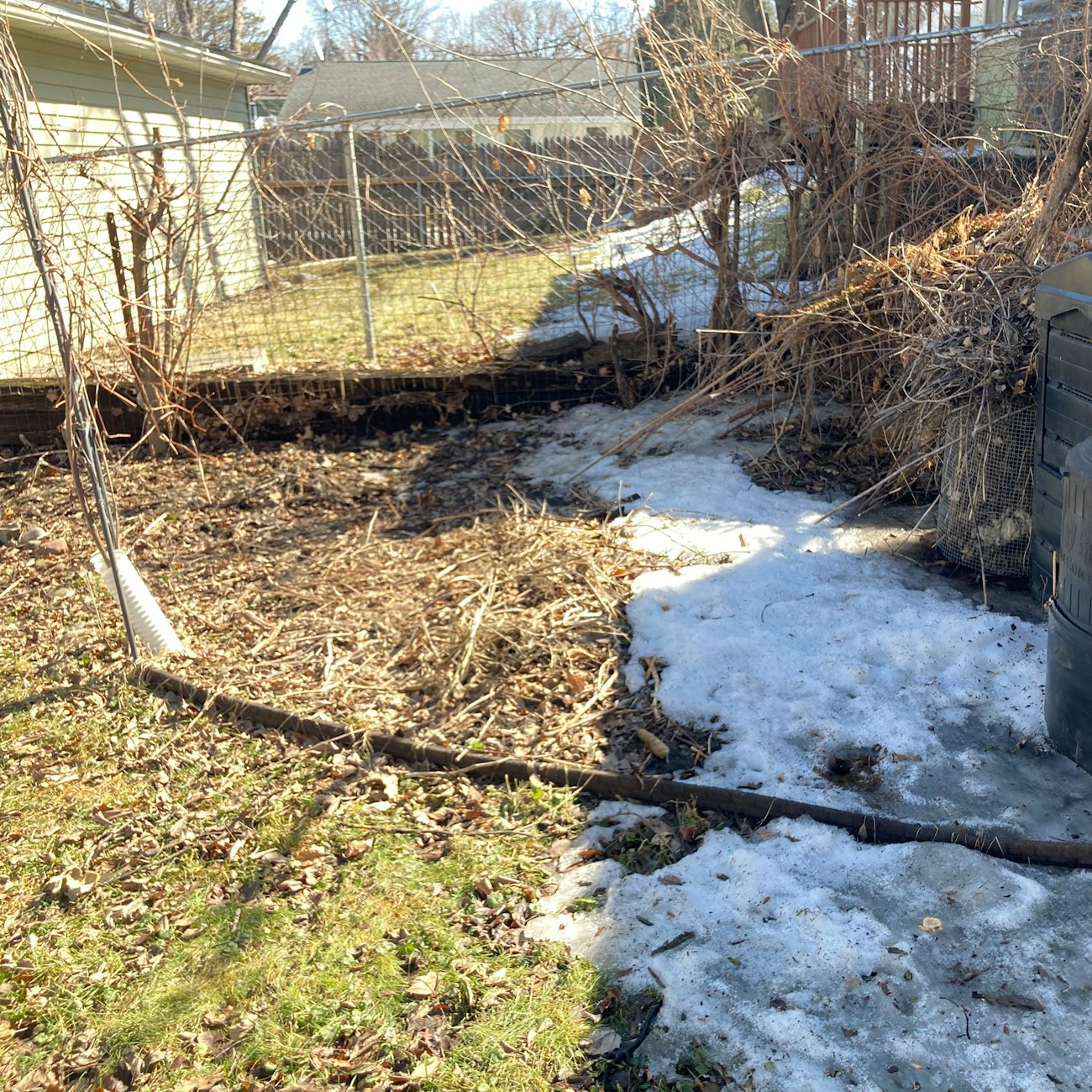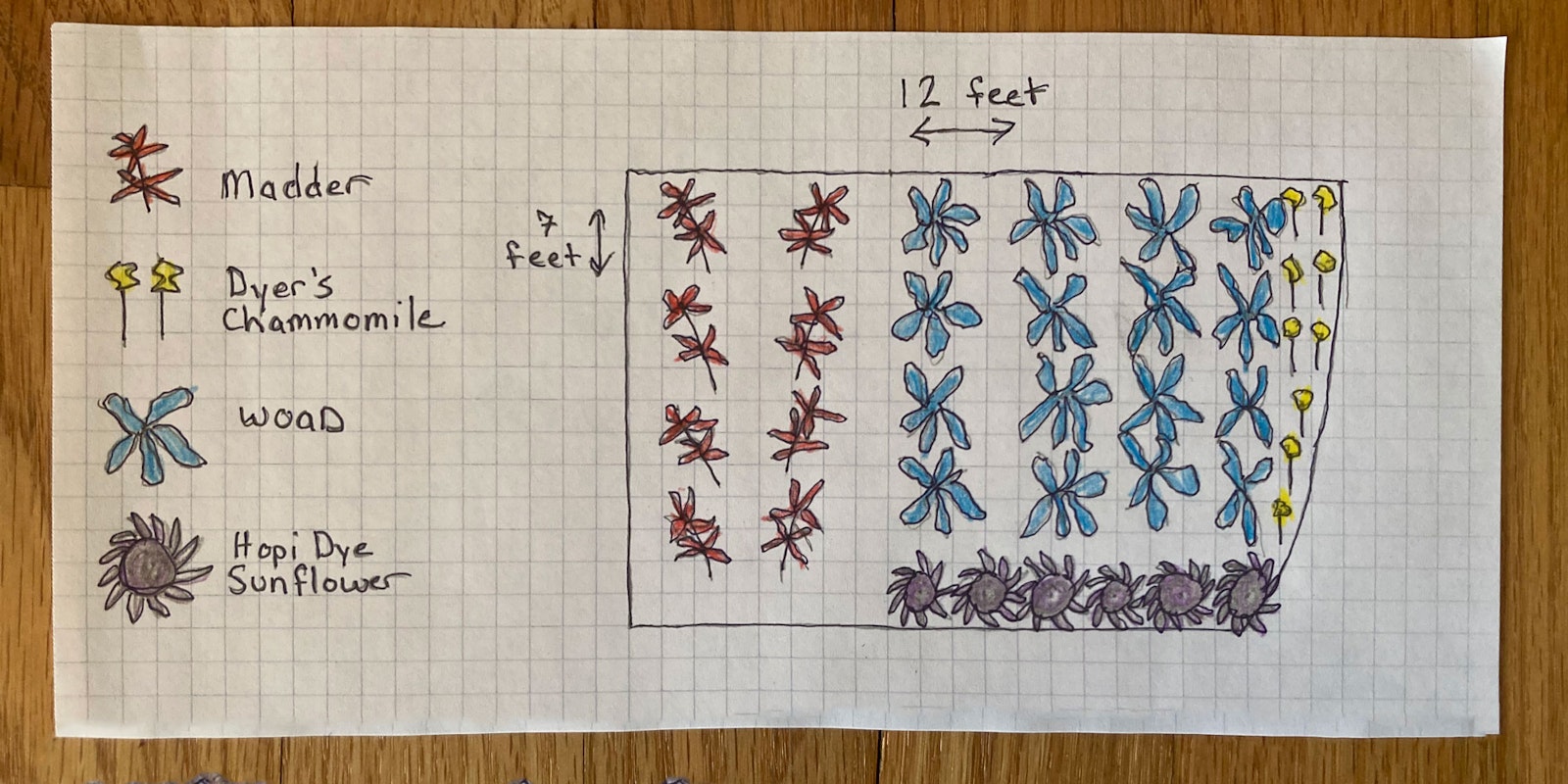Ever since I read Journeys in Natural Dyeing by Kristine Vejar and Adrienne Rodriguez, I have been fascinated with the idea of creating a color palette made up uniquely of the natural dyes that grow well or can be foraged from my location, Saint Louis Park, Minnesota. I am technically in plant hardiness Zone 4, though being in a first-ring suburb and with climate change, I am moving very close to Zone 5.
There is a no-man’s-land between our garden shed and compost bins and perennial gardens, which has hosted strawberries, weeds, composting bulk materials, brush removed from the overgrown lilac hedge, bags of leaves . . . The list can go on and on, and I am determined to make it a beautiful and productive dye garden.

Devin has big dye-garden plans for this unused 12 x 7 foot patch of their yard. Photo by Devin Helmen
Choosing Dye Plants
I have grown some dye plants in the past: Japanese indigo (Persicaria tinctoria), a lonely madder plant (Rubia tinctorum) shoved into the ground three years ago, dyer’s chamomile (Cota tinctoria) slotted into perennial borders, marigolds (Tagetes spp.) among the tomatoes.
I chose the plants in my new dye garden with an eye to what will grow well in this climate—and to laziness. I love madder reds and oranges and so chose madder, since it is a perennial that is already growing well. Blue is a favorite color, as are the greens made by overdyeing with yellow. Japanese indigo is a great source of blue, but it needs to be started indoors in my climate and rarely produces seed in Zone 4. I far prefer to save the labor and worry of starting seeds, and so I chose woad (Isatis tinctoria). I can direct-seed woad, and it is a biennial that will set seed in my climate, so I can save seed the second year to replant. Dyer’s chamomile is my go-to yellow for my climate; it produces a very bright and clear yellow, overdyes wonderfully to make greens, and is a beautiful plant that looks great in flower gardens. As a last plant, I chose something fun in order to experiment: Hopi dye sunflower (Helianthus annuus macrocarpus), which I have never used before. It will produce sunflower seeds for eating and sunflower hulls for dyeing a grayish-lavender color.
Note: Dyer’s woad can spread readily and is considered a noxious weed in 10 Western states, though it is not on Minnesota’s list of noxious and prohibited weeds. Check your state’s division of agriculture before planting woad, and take care to prevent the accidental spread of any seeds.
Garden Plans & Preparations
The available space is about 12 feet deep and 7 feet wide, and it backs onto the retaining wall and fence between the neighbor’s yard and ours. My madder plant has been flourishing in benign neglect at the rear of the space. In front of that is a space sandwiched between a grape arbor shading the entrance to a path and the compost bins. Last fall I turned the soil and covered it with compost, and it is ready to be planted.
This year I plan to dig up my single madder and divide it into six plants spaced evenly, making sure the soil is weeded and mulched and nourished to encourage the new plants to grow. In three years, I will (hopefully) be able to dig up an abundance of madder roots for dyeing and still have a thriving bed that will continue to grow and supply dyestuffs for many years. The woad will be direct-seeded in rows, then thinned out to about one plant per foot. Around the edges of the garden, I have placed the dyer’s chamomile and the sunflowers. The dyer’s chamomile will come from plants I have throughout my yard that need to be split. It will create a beautiful border and make picking the flowers easy; I pick them daily in the summer and dry them for dyeing throughout the year. The sunflowers will also create a pretty border between the garden path and the less sightly woad.
In the first year, I will be able to dye blue with woad, yellow with dyer’s chamomile, green with a combination of these two, and lavender-gray with the Hopi dye sunflower. In three years, when the madder roots have gotten big enough, I will be able to add madder reds and oranges to the colors I can produce from plants I grow. These, with the addition of native plants and invasives that I can forage from my neighborhood and local parks, will give me a palette of colors rooted in my landscape and personal to me.
Devin Helmen has been immersed in fiber since learning to spin at age 8. They spin, knit, and weave in beautiful Minnesota. Devin enjoys writing and teaching about fiber arts and has a passion for spindles and everyday textiles. They blog, intermittently, at www.afewgreenfigs.blogspot.com.

